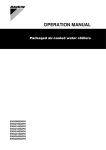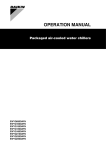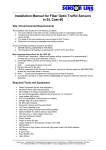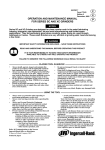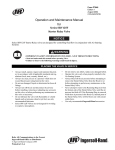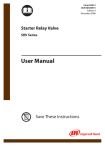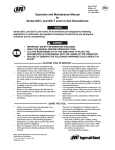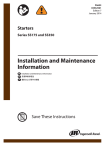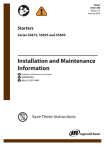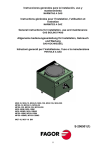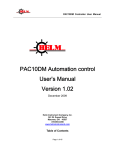Download Ingersoll-Rand 150BMG Remote Starter User Manual
Transcript
Form P6031 03524832 Edition 12 January 2011 Air and Gas Powered Starter Series 150BMG Installation and Maintenance Information Save These Instructions Product Safety Information Intended Use: The 150BMG Series Air starters are intended for use in starting reciprocating internal combustion engines. These starters are designed to be operated from a remote location after proper installation on the engine requiring starting. For Additional information refer to Air Starters Product Safety Information Manual Form 45558624. Manuals can be downloaded from www.ingersollrandproducts.com Lubrication Ingersoll Rand strongly emphasizes the importance of proper lubrication for achieving top performance and maximum durability with this starter. Either one of two lubrication systems is recommended. For typical starter installations where the cranking cycle is less than 10 seconds, we recommend an Ingersoll Rand No. HDL3 Lubricator installed as shown in Dwg. TPC585. Use either diesel fuel or 10W nondetergent motor oil for lubricating the starter. If the cranking cycle is more than 10 seconds, we recommend the Ingersoll Rand No. Lubricator NL-24-8 installed in the main air supply line. Use a good quality 10W nondetergent oil and adjust the lubricator to flow 1 to 3 drops per second. NOTICE When an HDL3 Lubricator is used, make certain that the oil supply line pressure is no greater than 5 psi. If there is pressure on the line, the lubricator will continuously leak lubricant through the starter and out of the exhaust. Placing the Starter in Service How to Order a Starter MODEL CODING Drive Orientation Code 150 BM G E 21 RH 6- 0 2 0 Size Starter Drive Housing Exhaust Type Starter Gas Sealed Gearing Drive Housing Inlet Type Pinion Rotation (Dwg. TPD1732) For specific models or special applications, contact your nearest Ingersoll-Rand Distributor or Ingersoll-Rand Engine Starting Systems, Box 8000, Southern Pines, NC 28387 (910) 692-8700. Installation NOTICE For maximum performance, read this manual prior to installation or operation of Series 150BMG Starters. General Information 1. This starter must be installed according to the instructions in this manual. 2. Ingersoll-Rand recommends that on all vehicular installations and on stationary engines subject to vibration, hoses of the specified diameter be used instead of rigid pipe connections. Vehicle and engine vibration will soon loosen rigid pipe connections, whereas hoses will absorb the vibration, and connections will remain tight. 3. When mounting a starter, make the hose connections at the receiver and have the starter end of the hose handy for attaching to the starter. Wherever possible, attach the air hoses to the starter before mounting the starter on the flywheel housing. There are two reasons for following this procedure: a. After mounting the starter, it is often impossible to make hose connections due to space limitations. b. Once attached, the hoses carry some of the weight of the starter, making it easier to complete the mounting. 2 4. Engine design often demands that the starter be mounted underneath in extremely close quarters. Therefore, even though two of the mounting bolt holes are easy to get at, the third one is often difficult to reach. The tools usually needed in the installation of a starter are a regular ratchet wrench, sockets, universal joint, socket extension and a single or double-end ratcheting box wrench. 5. The efficiency of a starter can be greatly impaired by an improper hook-up. Hoses smaller than those recommended will reduce the volume of air to the motor, and the use of reducers in the exhaust port will restrict the exhaust and choke the motor. The use of tees and elbows and the length of the supply line should be kept to a minimum. In normal installations, hoses running from the air tank to the starter should be No. 20 and fittings should be 1-1/4”. Control hoses should be No. 4 and fittings should be 1/4”. 6. A leak in any of the connections means that the system will drain overnight and will have to be repressurized the next morning by using another vehicle or compressor. Make the connections right the first time to avoid unnecessary costs and delays. On all threaded connections throughout the system, use Ingersoll-Rand No. SMB-441 Sealant, non-hardening No.2 Permatex, Loctite®* Pipe Sealant or Perma-Lok® LH050**. Always run the air supply line from the side or top of the receiver, never at or near the bottom. Moisture will collect at the bottom of the receiver 03524832_ed12 causing corrosion and icing in cold weather. If either of these conditions exist, the starter will not operate. After all connections have been made, check each joint with a soap bubble test, 7. Installation of a “glad hand” for emergency repressurizing the system is recommended. To keep the “glad hand” clean and free of dirt, and to protect it from distortion, a second “glad hand” closed by a pipe plug can be mated to it, or a glad hand protector bracket can be used. 8. Whenever possible, always mount the starter so that the exhaust port is downward This will help prevent any accumulation of water in the starter motor. 9. For increased protection during extended shelf life, the motor components of the starter have been coated with Ingersoll Rand No. 50 Oil. This oil will be dispersed during the first few cycles of the starter. Relay Valve Location Ingersoll-Rand recommends that the Relay Valve be mounted on the air tank. As an alternate location, the Relay Valve can be mounted on the starter. Mounting on the starter gives better control of the air supply closer to the point of use and provides more starts per tank of air. However, mounting on the starter adds overhung weight and subjects the air supply lines to dynamic pressure at all times. * Registered Trademark of Loctite Corporation ** Registered Trademark of Permabond Corporation Orientation of the Air Starter If the factory orientation will not fit your engine due to radial location of the Drive Housing or location of the inlet and/or exhaust ports, re-orient the starter as follows: 1. Refer to the dimension illustration and note that the drive housing can be located in anyone of eighteen radial positions relative to the gear case. The exhaust port (motor housing) can be located in any one of four radial positions relative to the Gear Case, and the air inlet (Motor Housing Cover) can be located in any one of four radial positions relative to the exhaust port. 2. Study the engine mounting requirements, and determine the required orientation of the Drive Housing relative to the Gear Case. If the Drive Housing has to be reoriented, remove the twelve Drive Housing Cap Screws and rotate the Drive Housing to its required position. NOTICE Do not separate the Drive Housing from the Gear Case Cover. Reinstall the Drive Housing Cap Screws and tighten them to 100 in-lb (11 Nm) of torque. 3. When orienting the Drive Housing relative to the Gear Case, determine if the exhaust port will be at the bottom and if the inlet port will be favorably located for hose installation. If either or both of these members must be reoriented, remove the four Motor Housing Cover Cap Screws, and rotate the Motor Housing and/or Motor Housing Cover to its desired position. NOTICE Do not separate these members from each other or from the Gear Case. Reinstall the Motor Housing Cover Cap Screws and alternately tighten them to 25 ft-lb (34 Nm) of torque. Mounting the Air Starter 1. Study the piping diagram Dwg. TPC585. 2. The air receiver tank for a starter installation must meet SAE J10B specifications or conform to ASME specifications. It must have a working pressure capability equal to or greater than the maximum pressure at which the starter will be operated. 3. When connecting the starter to a receiver tank that is already in service, bleed off the air pressure by opening the drain valve. WARNING Bleed off the air pressure through a valve or petcock. Do not remove a plug from the tank while the tank is still pressurized. Drain off any water that has accumulated in the bottom of the tank. 4. Using a 1-1/4” short nipple, install the SRV125 Starter Relay Valve on the end of the receiver tank as shown in the piping diagram. 03524832_ed12 NOTICE Make certain the connection is made to the inlet side of the Relay Valve indicated by the word ‘IN” cast on the valve body. 5. Install the No. SMB-618 Starter Control Valve on the dash panel (for vehicular installations) or some other appropriate panel (for stationary installations). 6. Attach No. TA-STR-100 Starter Instruction Label to the control panel adjacent to the Starter Control Valve. 7. Mount the No. 150BMP-1064 Air Pressure Gauge on or adjacent to the control panel. It should be located where it is readily visible to the operator of the Control Valve. 8. Connect the Starter Control Valve to the Relay Valve with 1/4” hose. Install a Tee in this line with a short feeder hose to the Pressure Gauge. NOTICE Make certain the hose is connected to the “SUPPLY” side of the Starter Control Valve. 9. To determine the exact length of 1-1/4” air hose required, run a piece of heavy-duty hose or some other flexible tubing of the same diameter from the Relay Valve on the receiver to the Starter location on the engine. 10. Attach the 1-1/4” air hose to the outlet side of the Relay Valve, and run the hose through the frame to its final position at the starter location. 11. At this point, determine if it is feasible or practical to attach the hose to the starter before or after the starter is actually mounted. In many cases, it may be necessary to attach the hose to the starter before mounting. 12. If possible, liberally grease the teeth on the ring gear with a good, sticky gear grease or motorcycle chain lube. This will help promote the life of the ring gear and the Starter Pinion. 13. Place the starter into position, and mount it on the flywheel bell housing. Tighten the mounting bolts to 100 ft-lb (136 Nm) of torque. 14. If the exhaust is not to be piped away, install a No. 150BM-A674 Muffler or No. 150BM-A735 Road Splash Deflector in the exhaust port on the Motor Housing of the Starter. 15. Pressurize the complete starting system and check every connection with a soap bubble test. There must be no leaks. Barring Over the Engine Occasionally, for setting injectors and/or for timing purposes, it may be desirable to bar over the engine in such a manner that any given piston can be stopped at any given location. This is very easily done with a 150BMG Starter. 3 1. Disconnect the 1/4” hose at the “OUT” port on the Drive Housing, and plug the hole in the Drive Housing with a 1/4” pipe plug. 2. Remove the 3/8” pipe plug from the center of the Motor Housing Cover. 3. Engage the Drive Pinion with the flywheel by applying a minimum of 70 psig (4.8 bar/483kPa) to the “IN” port on the Drive Housing. 4. Insert a 5/16” hexagonal wrench through the hole in the Motor Housing Cover to engage the hexagonal recess at the rear of the Rotor. 5. Manually, rotate the Rotor until the engine is cranked to its desired position. Gas Operated Starters WARNING When repairing a gas-operated starter or when converting a starter from air operation to gas operation, it is necessary to use Ingersoll-Rand No. MBA31 Plastic Gasket, as directed, and the following procedures for assembly and testing must be explicitly followed. 4 1. Apply a thin film of sealant to the Housing Cover End Plug and the Lubricator Port Plug as they are assembled. 2. Plug the exhaust. Connect air line to the inlet, regulate the air pressure to 40 psig (2.8 bar/280 kPa) and immerse the unit for 30 seconds in light oil, or non-flammable solvent. If there are any bubbles, the unit is unfit for gas operation. Tighten where necessary and/or apply sealant to area showing leak. Retest. 03524832_ed12 03524832_ed12 3.56 3.25 1 1/4 -11 1/2 NPT Inlet 1 1/4 -11 1/2 NPT Exhaust 4 Capscrews Motor Housing may be rotated to any one of 4 Angular positions to provide Engine Clearance Cover 2.00 R 1.25 Motor Housing 12.34 3. 4. 5. 6. 2. 1. Performance Data @ 120 psi 108 146 ft/lbs Nm MAX TORQUE Orientation Options Motor Housing Gear Case 4 @90º 4 @90º 21.3 2.46 MAX HP @ RPM 1740 Drive Housing 18 @ 20º These Models available Gas Sealed. Identify with a “G” in the Model, Example: 150BMGE21RH-6 These Models have 4-Bolt Mounting Flange (Drive Housing 9BM-300-4) This Model has SAE No. 1 Mounting Flange (Drive Housing 10BM-300-1) Any previously published model not listed at right will require price and delivery quotation. Model “E” Ratio Cover 4 @90º Notes: 1. Starters should be installed on the Engine with the exhaust pointed down. 2. Use the set of control ports on the upper side of the Drive Housing. (Only Drive Housings with two sets of Control Ports) 3. Drive Housing Orientation code is based on Position of mounting hole opposite the Pinion Opening. 4. Please read the instructions before attempting to reorient. 5. Starter wieght: 38lbs (17.5 kg) 6. Lubricator and Muffler Included. Std Tolerances unless otherwise specified .xx = ±.010 .xxx = ±.005 xº = ±.5º 3/8 -18 NPT Lube connection 18.03 12 Capscrews Drive Housing may be rotated to any one of 18 Angular positions to provide Engine Clearance Drive Housing 3.25 (3) (3) (3) (4) (4) (3) (5) 4.44 13 8/10 150BME21LH-11 150BME21RH-6 150BMC21RH-39 150BMC22RH-38 150BME21LH-37 150BME22RH-5 10BM-299-19 A-3238 10BM-299-21 A-3233 12 6/8 11 12 6/8 11 12 6/8 Replace with 150BME21RH-6 Replace with 150BME22RH-5 Replace with 150BME21LH-11 11 10BM-299-21 A-3233 A-3242 8/10 DP Pinion Data Blank Size 150BME21RH-31 9BM-299-4 13 No. of Teeth 10BM-299-21 A-3233 11 6/8 10BM-299-22 A-3344 12 8/10 Price and Delivery must be confirmed on above models 10BM-299-22 A-3344 12 13 8/10 150BME22LH-8 A-3400 Facet Normally Available Models Left Hand or Counter Clockwise Rotation 120˚ 72˚30’ 150BME23RH-12 150BME24RH-19 9BM-299-9 IR Drive Number Ø 3.624 150BME12RH-13 Model * PD for Lay Out Purpose Gear Case Ø 5.25 8.69 6.0 2.000 2.000 2.000 1.625 2.000 1.625 1.625 1.625 PD* 20º 20º 20º 20º 20º 20º 20º 20º PA (Dwg. TPA1441) Right Hand or Clockwise Rotation Ø 4.718 120˚ R 2.359 150BMG Series Air and Gas Starters Dimensional Drawing 5 150BMG Series Air and Gas Starters Typical Installation Starter control Valve SMB-G6618 # 4 Hose (1/4”) # 4 Hose (1/4”) # 4 Hose (1/4”) Air Pressure Gage 150BMP-1064L JIC 37˚ Adapter 1/4 NPT Check Valve 150BMP-1056 JIC 37˚ Adapter 1 1/2 NPT Air Supply Air Receiver Tank See Recommended Hose Size 1 1/2” NPT HDL3 Luricator Drain Valve 150BMP-1067 1/2 NPT Note: Use Seleant on all pipe connections. SMB-441 For Gas Operation the exhaust outlet must be piped away to a safe location. Ingersoll Rand Part Number For Natural Gas Operation, Piped Exhaust must be used and Drive Housing vent plug replaced with suitable hose which connects into piped exhaust system. The performance of the Starter is dependent on the pressure at the inlet of the starter. This pressure is effected by the pressure drop between the Air Receiver Tank and the Starter. The most significant pressure drops will occur in fittings (Valves, Tees, Elbows, etc.) The next significant source of pressure drop is the hose. The following table provides recommended hose and Starter Relay Valves (SRV) sizes for typical one starter installations. Systems with many fittings or long hose should be analyzed and sized individually. (Dwg. TPC585) Hose Length Starter 3BM, 5BM SS175 150BM/LF, SS350 0-30’ 0-30’ 0-10’ 10-30’ SS810, 815, 825, 850 ST750, 799 0-50’ For Air Applications a Muffler or Splash Guard Deflector must be used. Hose Size SRV Size # 12 (3/4 “) # 12 (3/4 “) # 16 (1 “) # 20 (1 1/4“) # 24 (1 1/2“) SRV 100 SRV 100 SRV 100 SRV 125 SRV 150 Series 150BM and 150BMG Performance Curves 120 25 1200 20 900 15 600 Flow (SCFM) 100 60 Power (HP) Torque (lb-ft) 80 40 10 300 5 0 20 0 0 (Dwg. TPC611) 6 500 1000 1500 Speed (RPM) 2000 2500 3000 03524832_ed12 03524832_ed12 2 1 10 7 6 5 2 8 9 40 55 11 12 13 21 16 18A 18 15 19A 20 19 14 39 55 38 36 37 22 35 56 34 33 24 23 53 52 32 Air Strainer 51 31 27 54 30 150BMG Series Air and Gas Starters Sectional View (Dwg. TPA61-7) 7 30 19A 18A 5 15 2 6 56 16 2 18 19 1 34 21 55 33 22 7 9 20 8 32 10 31 13 40 23 11 24 37 27 36 39 35 12 14 55 38 150BMG Series Air and Gas Starters Exploded View (Dwg. TPA683-2) 8 03524832_ed12 150BMG Series Air and Gas Starters Parts List Item Part Description 1 2 * * Motor Housing Cover Assembly Housing Cover End Plug (3) Nameplate Nameplate Screw (3) 5 Motor Housing Cover Cap Screw (4) 6 Part Number 150BMP-A102A HSPPS3 150BM-301 R4K-302 Item 32 107-25 Part Description Drive Shaft for Model E22RH5-020 for Models C21RH-6, C21LH-11, C21RH-16, C21RH-17, C21RH-31, C21LH-32, E21RH6-20 Cover Cap Screw Washer (4) D02-504 †7 Motor Housing Cover Gasket 150LF-283 ‡ 33 Drive Shaft Collar †8 Rear Rotor Bearing R3H-24 † 34 Drive Shaft Front Bearing G57-729 150LF-12A 150BM-3 10BM-98 10BM-42-5 10BM-40 10BM-37 10BM-25 10BM-399 R2-227 † 35 36 Rotor Pinion Retainer Rotor Pinion for “C” Models for “E” Models Front Rotor Bearing Gear Case Gasket Front End Plate Rotor Air Strainer Assembly Air Strainer Cap Air Strainer Plug Air Strainer Screen Gasket (2) Gasket Air Strainer Nipple (1-1/4” x 2-1/2”) Mounting Adapter Mounting Adapter Mounting Adapter Road Splash Deflector Assembly Muffler Assembly Plastic Gasket Pipe Sealant Tune-up Kit (includes illustrated parts 7, 8, 9, 13, 16, 18, 19A,20, 22, 30, 34, 35, 37, and 38) †9 10 11 12 † 13 14 15 † 16 † 18 18A 19 † 19A † 20 21 † 22 23 24 27 † ‡ 30 ‡ 31 Rear Rotor Bearing Retainer Rear End Plate Cylinder Cylinder Dowel Vane Packet (set of 5 Vanes) Motor Housing Gear Case Assembly Bearing Ejecting Washer Drive Shaft Rear Bearing Plug Drive Gear for C models for E models Drive Gear Thrust Washer Drive Gear Key Gear Case Cover Assembly for Model C12RH-13 for all other models Drive Shaft Grease Seal Drive Housing Cap Screw Lock Washer (12) Drive Housing Cap Screw (12) Drive Housing Assembly Drive Housing Bearing Starter Drive 10BMC-9 150BME-9 10BM-15 10BM-610 10BM-378 10BM-478 150BMP-271 --10BM-67 10BM-744 9BM-A300-H2 ML50K-318 10BM-299-21 for Models BM21LH-11 and BMG21LH-11 10BM-299-19 for Models BM21RH-5 and BMG22RH-5 10BM-299-22 for Models BM21RH-6 and BMG21RH-6 Part Number 10BM-108 10BM-8 E21LH11-020 † 37 † 38 39 40 # 51 52 53 54 55 56 * * * * * * * * * 10BM-30 T02-33 10BM-69 101BMPD-17 150BME-17 10BM-24 150LF-284 150LF-11A 10BMP-53 K4U-A267AT K4U-286AT 22SR-165 K4U-61AT 150BMP-283 150BMP-284 KKM-286 9BM-B212-5/8 9BM-B212-1 10BM-CU212-1/2 150BM-A735 150BM-A674 SMB-431 SM-441 150BM-TK2 * Not Illustrated † Indicates Tune-up Kit part. ‡ For every C model listed, there is a comparable E model. With the exception of the Drive Gear (19) and Rotor Pinion (36), comparable C and E models are identical. # Recommended on applications where air or gas could be contaminated. 03524832_ed12 9 Maintenance Section WARNING Always wear eye protection when operating or performing any maintenance on this Starter. Always turn off the air or Gas supply and disconnect the air supply hose before installing, removing or adjusting any accessory on this Starter or before performing any maintenance on this Starter. Note: When reading the instructions, refer to exploded diagrams in parts Information Section when applicable. Lubrication Each time a Model 150BMG Starter is disassembled for maintenance or repair, lubricate the starter as follows: 1. Lubricate all open bearing and gear teeth with a liberal coat of Ingersoll Rand No. 130 Grease. 2. Cover the bore of the Motor Housing Cover (1) with Ingersoll Rand No. 130 Grease. 3. Apply a thin film of Ingersoll Rand No. 130 Grease to the Drive Shaft (32) and the bore of the Drive Shaft Front Bearing (34), Drive Shaft Collar (33) and Drive Gear (19). Disassembly of the Starter General Instructions 1. Do not disassemble the starter any further than necessary to replace worn or damaged parts. 2. When grasping a part in a vise, always use leather covered or copper-covered vise jaws to protect the surface of the part and help prevent distortion. This is particularly true of threaded members. 3. Do not remove any part which is a press fit in or on a subassembly unless the removal of that part is necessary for replacement or repairs. 4. Always have a complete set of seals and O-rings on hand before starting any overhaul of a Model 150BMG Starter. Never reuse old seals or gaskets. 5. Always mark adjacent parts on the Motor Housing Cover (1), Motor Housing (14), Gear Case (15) and Drive Housing (27) so these members can be located in the same relative position when the starter is reassembled. 6. Never wash the Starter Drive (31) in a solvent. 7. Do not press any needle bearing from a part unless you have a new needle bearing on hand for installation. Needle bearings are always damaged during the removal process. Disassembly of the Motor 1. 2. 3. 4. Unscrew the Motor Housing Cover Cap Screws (5). Pull the Motor Housing Cover (1) from the Motor Housing (14). Slide the Motor Housing from the motor. Grasp the rear end of the motor and pull the entire assembly away from the Gear Case (15). 5. Position the motor assembly vertically, grasping the Rotor Pinion (36) in leather-covered or copper-covered vise jaws. 6. Remove the Rear Rotor Bearing Retainer (9). 7. The Rear Rotor Bearing (8) is press fit on the rotor shaft. Use a bearing puller to remove it. 8. Lift off the Rear End Plate (10) and Cylinder (11) and remove the Vanes (13) from the slots in the Rotor. 9. Reposition the Rotor vertically, pinion end up, and grasp the short hub in leather-covered or copper-covered vise jaws. 10. Remove the Rotor Pinion Retainer (35) and lift off the Rotor Pinion (36). 11. Support the Front End Plate (39) as close to the Rotor as possible, and press the Rotor from the Front Rotor Bearing (37). Do not let the Rotor fall when it is pressed free. Disassembly of the Gear Case 1. Set the gear case and drive housing unit upright on the workbench with the Drive Housing (27) upward. 10 4. Wipe a thin film of Ingersoll Rand No. 130 Grease on the Drive Gear Thrust Washer (19A). 5. Apply about 8 ounces of Ingersoll Rand No. 130 Grease to the assembled Drive Gear (19) and a uniform coat to the Drive Shaft (32) working the grease between all gear teeth, splines and bearing surfaces. 6. Wipe a thin film of Ingersoll Rand No. 130 Grease in the bore of the Drive Housing (27). 2. Remove the Drive Housing Cap Screws (24) and Drive Housing Cap Screw Lock Washers (23) and lift off the Drive Housing, Drive Gear and Starter Drive. 3. Thread a 5/16”-18 thread cap screw into the tapped hole in the Bearing Ejecting Washer (16) and continue to turn it until the Drive Shaft Rear Bearing (18) is jacked from the Gear Case (15). Disassembly of the Drive Housing 1. With the Drive Housing unit lying on the workbench, grasp the Drive Gear (19) and pull the assembled Drive Shaft (32) from the Starter Drive (31). 2. If the Drive Gear must be removed from the Drive Shaft, support the Drive Gear on the table of an arbor press, and press the Drive Shaft from the Drive Gear. Remove the Drive Gear Key (20). 3. Stand the Drive Shaft assembly, bearing end up, in a sleeve that contacts the Drive Shaft Collar (33), and press the Drive Shaft from the bore of the Drive Shaft Front Bearing (34). 4. Position the Drive Housing (27) vertically, grasping the Gear Case Cover (21) in leather-covered or copper-covered vise jaws. Tap the underside of the drive housing mounting flange with a soft hammer to dislodge the Drive Housing from the Gear Case Cover. Lift off the Drive Housing. The Starter Drive will probably remain with the Drive Housing; make certain that it does not fall on the floor. NOTICE Do not remove the Drive Shaft Grease Seal (22) from the Gear Case Cover unless it is absolutely necessary and you have a new Seal on hand. If the Seal must be removed, press it from the Gear Case Cover. 5. Do not remove the Drive Housing Bearing (30) from the Drive Housing unless you have a new Bushing on hand. If the Bearing must be removed, press it from the Drive Housing. Cleaning the Parts Once the Starter has been disassembled, clean all parts for inspection. 1. Wipe all dirt, grease, etc. from the Starter Drive and sealed bearings. NOTICE Do not wash these parts in kerosene or other solvent, as this will dilute and contaminate any sealed-in lifetime lubricant. 2. Wash all parts except the Start Drive or any sealed bearing in clean kerosene or other solvent. Dry the parts with compressed air. 03524832_ed12 Inspection of Parts 1. Discard all O-rings and gaskets. These should not be reused. 2. Check all grease seals. If they appear worn or distorted, remove them from their parent member and discard. NOTICE Discard any grease seal that was removed during disassembly of the starter. Assembly General Instructions Assembly of Motor 1. Always press on the inner ring of a ball-type bearing when installing the bearing on a shaft. 2. Always press on the outer ring of a ball-type bearing when pressing the bearing into a bearing recess. 3. Whenever grasping a starter or part in a vise, always use leather-covered or copper-covered vise jaws. Take extra care with threaded parts or housings. 4. Always clean every part and wipe every part with a thin film of Ingersoll Rand No. 50 Oil before installation. 5. Check every bearing for roughness. If an open bearing must be cleaned, wash it thoroughly in a clean, suitable, cleaning solution and dry with a clean cloth. Sealed or shielded bearings should never be cleaned. Work Ingersoll Rand No. 130 Grease thoroughly into every open bearing before installation. 6. Apply a film of o-ring lubricant to all o-rings before final assembly. 7. Lubricate all open bearing and gear teeth with a liberal coat of Ingersoll Rand No. 130 Grease. Lubricate Starter Drive Housing Bearing (30) and gear teeth with a liberal coat of Ingersoll Rand No. 130 Grease. Work about 3 cc into the teeth of the Drive Gear. 8. Lubricate the Gear Case and Gear Case components with Ingersoll Rand No. 130 Grease. 9. When assembling the motor always use new O-rings. 10. Before installing O-rings, coat liberally with O-ring lubricant. After the O-ring is installed, coat the O-ring again with o-ring lubricant and apply O-ring lubricant to O-ring grooves. 11. The Cylinder Dowel (12) maintains the alignment of the Motor Housing Cover (1), Front End Plate (39), Cylinder (11) and Rear End Plate (10). The end of the Dowel fits into a shallow hole in the face of the Motor Housing Cover. It is important that the end of the Dowel is in the hole and remains there during assembly. 12. Unless otherwise noted, always press on the stamped end of a needle bearing when installing the needle bearing in a recess. Use a bearing inserting tool similar to the one shown in Dwg. TPD786. Needle Bearing inserting Tool Shoulder to Regulate Depth 3. Check all needle bearings. Discard any needle bearing that was pressed from a parent member during disassembly of the starter. Remove and discard any other needle bearing that appears worn, distorted, has loose needles or does not run freely. 4. Check all ball bearings. These should run freely without any rough spots or binding. Discard any bearing that gives any indication of wear. Check the Vanes for separation, chipping, wear, checks, etc. See that they fit freely in the vane slots in the Rotor. We recommend that a complete new set of Vanes be installed whenever the Starter is disassembled. 15° Pilot to fit I.D. of Bearing. Length of Pilot to be approximately 1/8” less than length of Bearing 1. Position the Rotor (40) vertically, splined end down. 2. Place the Rear End Plate (10), crescent grooved side first, onto the hub of the Rotor. NOTICE Make sure that all notches and ports are in alignment. Refer to Dwg. TPA683-2. 3. Install the Rear Rotor Bearing (8) onto the hub of the Rotor until it contacts the Rear End Plate. Make certain the End Plate does not bind against the Rotor. 4. Install the Rear Rotor Bearing Retainer (9) in the groove on the hub of the Rotor. 5. Grasp the Motor Housing Cover (1), motor bore face upward, in copper-covered or leather-covered vise jaws. Swivel the vise so that the air inlet is facing you. Cover the bore of the bearing recess with a thin film of Ingersoll Rand No. 130 Grease. 6. Check the nameplate on the Starter to determine whether you have an “LH” model or “RH” model. For “LH” models: While facing the air inlet on the Motor Housing Cover, insert the Cylinder Dowel (12) in the dowel hole on the right of the inlet. For “RH” models: While facing the air inlet on the Motor Housing Cover, insert the Cylinder Dowel (12) in the dowel hole on the left of the inlet. NOTICE Make certain the Cylinder Dowel is installed in the proper dowel hole. If you put it in the wrong dowel hole, the motor will rotate in the wrong direction. 7. Place the Motor Housing Gasket (7) in the bore of the Motor Housing Cover. NOTICE Make sure that the Motor Housing Gasket is installed with the Cylinder Dowel hole positioned upward and properly oriented relative to the Cylinder Dowel. The Cylinder Dowel hole in the Gasket is the hole which is centered between the two angled ports in the Gasket. Refer to Dwg. TPA683-2. 8. Place the assembled End Plate and Rotor into the Motor Housing Cover that the Cylinder Dowel passes through the dowel hole in the End Plate, and so that the air port in the End Plate aligns with the port in the Gasket and Motor Housing Cover. 9. Place the Cylinder (11) down over the Rotor so that the Cylinder Dowel passes through the dowel hole in the Cylinder and so that the air port in the Cylinder is aligned with the air port in the Rear End Plate, Gasket, and Motor Housing Cover. 10. Place the Motor Housing (14) down over the Cylinder making certain that the prick punch marks on the Motor Housing Cover and Motor Housing are aligned. 11. Liberally coat each Vane (13) with Ingersoll Rand No. 50 Oil and insert a Vane into each slot in the Rotor. Make certain the straight edge of each Vane faces the Cylinder. (Dwg. TPD786) 03524832_ed12 11 12. Set the Front End Plate (39), crescent grooved side first, onto the Cylinder so that the Cylinder Dowel passes through the dowel hole in the End Plate. Make sure that all notches and ports are in alignment. 13. Install the Front Rotor Bearing (37) onto the splined shaft of the Rotor until it seats against the Front End Plate. Do not bind the End Plate against the Rotor. 14. Slide the Rotor Pinion (36) onto the rotor shaft. 15. Install the Rotor Pinion Retainer (35) in the groove on the rotor shaft so that the concave side of the Retainer faces the Rotor Pinion. 16. Apply a light coat of Ingersoll Rand No. 130 Grease to the Gear Case Gasket (38) and place the Gasket in the motor bore of the Gear Case. 17. Set the Gear Case on the assembled motor, making certain the prick punch marks on the Gear Case are aligned with those on the Motor Housing. 18. Turn the entire assembly over so that the Motor Housing Cover is upward. Make sure that the Cylinder Dowel remains seated in the shallow hole in the face of the Motor Housing Cover. 19. Install the Motor Housing Cover Cap Screws (5) and Lock Washers (6). Tighten the Cap Screws alternately to 25 ft-lb (34 Nm) of torque. Assembly of Drive Gear 1. If the Drive Shaft Grease Seal (22) was removed from the Gear Case Cover (21), press in a new Seal so that the inner lips of the Seal face the bearing recess for the Drive Shaft Front Bearing (34). 2. Apply a thin film of Ingersoll Rand No. 130 Grease to the Drive Shaft (32) and the bore of the Drive Shaft Front Bearing, Drive Shaft Collar (34), and Drive Gear (19). 3. Press the Drive Shaft Collar, beveled end first, onto the keyway end of the Drive Shaft until it seats against the shoulder of the shaft. 4. Press the Drive Shaft Front Bearing onto the keyway end of the Drive Shaft until it seats against the Drive Shaft Collar. Pack the Bearing with Ingersoll Rand No. 130 Grease. 5. Install the Drive Gear Key (20) in the keyway on the Drive Shaft. 6. Press the Drive Gear (19), long hub first, on the Drive Shaft until it contacts the Drive Shaft Front Bearing. Assembly of Gear Case 1. Set the assembled motor and Gear Case (15) on end with the Gear Case upward. 2. Place the Bearing Ejecting Washer (16) in the bearing recess. 3. Using a needle bearing inserting tool, press the Drive Shaft Rear Bearing (18), unstamped end first, into the bearing recess until the trailing face of the Bearing is flush with the face of the bearing recess. Refer to Dwg. TPD786. Work some Ingersoll Rand No. 130 Grease between the-rollers of the Bearing. 4. Wipe a thin film Ingersoll Rand No. 130 Grease on the Drive Gear Thrust Washer (19A), and place the Washer on the lip of the bearing recess in the Gear Case. 5. Apply about 8 ounces of Ingersoll Rand No. 130 Grease to the assembled Drive Gear (19) and a uniform coat of Ingersoll Rand No. 130 Grease to the Drive Shaft (32), making certain to work the grease between all the gear teeth, splines and bearing surfaces. 6. Insert the assembled Drive Gear and Shaft, short hub end first, into the Gear Case so that the short hub enters the Drive Rear Bearing. 7. Slide the assembled Gear Case Cover, bearing recess first, down over the Drive Shaft until it seats against the Gear Case. NOTICE Check the inner lip of the Drive Shaft Grease Seal to make certain that it did not fold outward toward the end of the Drive Shaft. If it did fold outward, you must reinstall the Gear Case Cover using a fine pointed instrument to roll the lip of the seal the proper direction. Assembly of Drive Housing 1. If the Drive Housing Bearing (30) was removed, stand the Drive Housing (27) upright and press a new Drive Housing Bearing, unstamped end first, into the Drive Housing until the unstamped end of the Bearing is flush with the inside face of the Drive Housing boss. Work some Ingersoll Rand No. 130 Grease in the Bearing. NOTICE Do not clean the Starter Drive (31) with solvent. If Starter Drive appears dry, apply Ingersoll Rand No. 130 Grease to the threads under the pinion. 2. Apply a thin film of Ingersoll Rand No. 130 Grease to the surface of the Drive Shaft (32). 3. Place the Starter Drive on the Drive Shaft. 4. Place the Drive Housing over the Drive onto the Gear Case Cover (21). Rotate the Drive Housing into the required orientation as indicated by the punch marks. At the same time, align the Cap Screw holes in the Gear Case Cover and Housing. 5. Install the Drive Housing Cap Screws (23) and Lock Washers (24) and tighten the Cap Screws to 100 in-lb (11 Nm) of torque. Testing the Starter 1. Turn the pinion by hand in the direction of Starter rotation. The pinion should advance smoothly and easily to the stop. 2. Turn the pinion opposite the direction of Starter rotation. The gearing and motor should rotate freely with no binding. 3. Attach an air hose to the inlet and operate the motor slowly to see that it functions properly and that the drive pinion rotates in the proper direction. If the direction of rotation is incorrect, the motor was improperly assembled. 12 4. The chambers on the pinion teeth should be on the following side of the teeth. 03524832_ed12 Troubleshooting Guide Trouble Probable Cause No air supply Motor will not run Solution Check for blockage or damage to air supply lines or tank. Damaged motor assembly Inspect Motor Assembly and power train and repair or replace if necessary. Foreign material in motor and/or piping Remove Motor Assembly and/or piping and remove blockage. Blocked exhaust system Remove Housing Exhaust Cover (1) and check for blockage. Defective Control Valve or Relay Valve Replace Control Valve or Relay Valve. Low air pressure to Starter Check air supply. Restricted air supply line. Check for blockage or damage to air lines. Relay Valve malfunctioning Clean or replace lines or Relay Valve. Lube Relay Valve. Exhaust flow restricted Check for blocked or damaged piping. Clean or replace piping. Check for dirt or foreign material and clean or remove. Check for ice build-up. Melt ice and reduce moisture build-up to Starter. Worn motor parts Remove the motor from the Motor Housing (14) and disassemble the motor. Examine all parts and replace any that are worn or damaged. Use the following guidelines for determining unserviceable parts: 1. Vanes (13): Install a new set of Vanes if any Vane is cracked, checked or worn. Loss of Power 2. Rotor Bearings (8) or (37): Replace if any roughness or looseness is apparent. 3. Rotor (40): Replace if there are any cracks or deep scoring. 4. Cylinder (11): Replace if there are any cracks or deep scoring. 5. End Plates (10) or (39): Clean up scoring by rubbing it with emery cloth placed on a flat surface. Lack of air to starter Check for clogged or damaged air line between relay valve and starter. Check relay valve to determine if it is functioning properly. Check air tank. Parts and Maintenance NOTICE The use of other than genuine Ingersoll Rand replacement parts may result in safety hazards, decreased starter performance, and increased maintenance, and may invalidate all warranties. Ingersoll Rand is not responsible for customer modification of starters for applications on which Ingersoll Rand was not consulted. Repairs should be made only by authorized trained personnel. Consult your nearest Ingersoll Rand Authorized Service center. When the life of the tool has expired, it is recommended that the starter be disassembled, degreased and parts be separated by material so that they can be recycled. Manuals can be downloaded from www.ingersollrandproducts.com Refer all communications to the nearest Ingersoll Rand Office or Distributor. 03524832_ed12 13 Notes: Notes: www.ingersollrandproducts.com © 2011 Ingersoll Rand
















